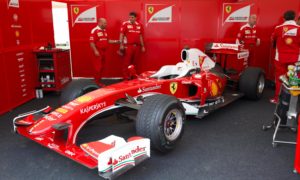 Forumula.net’s Hugh Podmore asks if Jenson Button’s assault on the drivers title is being overshadowed by the new rules.
Forumula.net’s Hugh Podmore asks if Jenson Button’s assault on the drivers title is being overshadowed by the new rules.
Jenson Button last weekend took his third win of the season, and only his fourth ever. His success has come at a time when the traditional order of the sport has been upended, and teams that last year would have frankly been thankful for points are now challenging for the world championship. The rule changes have ushered in a new era. But does this mean unequivocally that the car is the star now? Is the level of driver talent relevant? Or is F1 just a competition of machinery, like Robot Wars, these days?
Many would argue that for some years now, the driver’s contribution to the speed of the package has been considerably reduced. Such was the state of play by 1993, when Adrian Newey’s Williams FW15’s technological gizmos essentially ran the car for the driver. The FIA has been fighting a constant battle since, for example taking away active ride suspension, removing and then reinstating traction control (then removing it again), in order to retain some pretence of driver influence.
The rise of drivers such as Jacques Villeneuve confirm the sceptics’ view. Villeneuve won the world championship in 1997, in a vastly superior car to his rival Schumacher, yet had to take it down to the wire to do so. Villeneuve is invariably considered lower on Greatest Driver Ever lists than his achievement might warrant, however, perhaps because he is the driver who best symbolises the triumph of the machinery over the man.
Today many casual fans are heard asking why Button is at the top this season. To them the answer is clear; he now has a winning car, which was not at his disposal last season. The rule changes have permitted clever engineers to shine at the expense of their more illustrious rivals – a wonderful story, for engineers. But the driver today is irrelevant, goes the argument – we might as well have remote control F1 races.
There are several reasons why this analysis is flawed. The first is the oft-heard refrain about how great drivers always look good, even in terrible cars. The examples through recent F1 history are numerous; Ayrton Senna in his Toleman and Lotus days, Nigel Mansell, Michael Schumacher. Today the best examples are Fernando Alonso and to a lesser extent Lewis Hamilton. Alonso has been fighting with one hand behind his back for some years now, and still lands heavy punches. Hamilton is just lately finding out what it is like not to have a winning car and is acquitting himself superbly.
Perhaps this is because of the sheer breadth of talent the driver has to bring to the table. The driver is not only the one who has to drive the car faster than everyone else could, especially his team-mate. He has to set the thing up, with his experience, know-how and feedback the most important aspects of a car’s eventual race pace. He is also de facto team leader, representing all the garage and the factory in front of the world’s cameras and microphones. Lastly and perhaps most importantly, he has to be a politician, carefully manipulating the team, the suppliers and the sponsors into working for him. Senna, Schumacher and Prost were masters of all these aspects of a driver’s portfolio; Alonso is today.
The final word on the debate goes to Ross Brawn, subtly acknowledging the nuances of the driver vs car debate this week when talking about Jenson Button. “Even with the car we had last year I saw little flashes of something exceptional from him,” said the Brawn team principal. His intention was to reassure the world that Button was as much a key part of this year’s success as any diffuser.
Button may not be the greatest driver ever. But in showing up Rubens Barrichello, he is good enough to show that the average F1 driver is responsible for about 40% of the car’s performance. The other 60%, in normal cases, is down to the car. But where truly great drivers are concerned, that 40% can creep up, and up, until someone like Michael Schumacher in his Ferrari heyday might be said to be responsible for 60% of the package by himself. Incredible? Not really; as the old adage goes, the best drivers always seem to find themselves in the best cars.
In sum, in modern F1 it’s not really good enough for drivers to complain about the machinery and use it as an excuse why they are not impressing. They simply have to get more out of the car – because that’s part of their job description too. The best example today is Sebastian Vettel – a win for Toro Rosso last year, and quite possibly the difference between a winless Red Bull team and a winning one.








